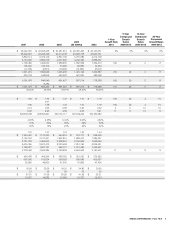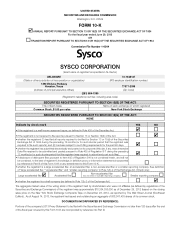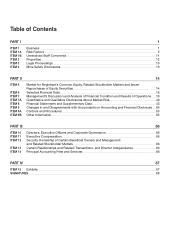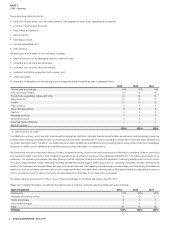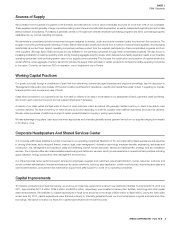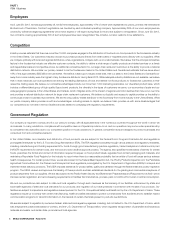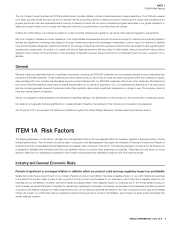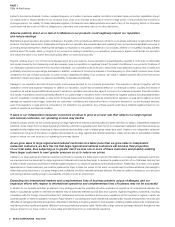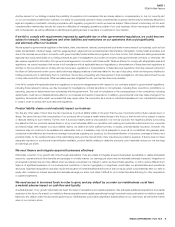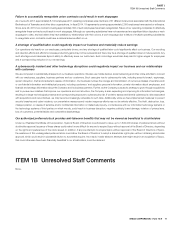Sysco 2013 Annual Report Download - page 19
Download and view the complete annual report
Please find page 19 of the 2013 Sysco annual report below. You can navigate through the pages in the report by either clicking on the pages listed below, or by using the keyword search tool below to find specific information within the annual report.SYSCO CORPORATION-Form10-K8
PARTI
ITEM1ARisk Factors
limited to food-borne illnesses). Further, increased frequency or duration of extreme weather conditions could also impair production capabilities, disrupt
our supply chain or impact demand for our products. Input costs could increase at any point in time for a large portion of the products that we sell for a
prolonged period. Our inability to obtain adequate supplies of foodservice and related products as a result of any of the foregoing factors or otherwise
could mean that we could not ful ll our obligations to customers, and customers may turn to other distributors.
Adverse publicity about us or lack of confi dence in our products could negatively impact our reputation
andreduceearnings
Maintaining a good reputation and public con dence in the safety of the products we distribute is critical to our business, particularly to selling Sysco Brand
products. The Sysco brand name, trademarks and logos and our reputation are powerful sales and marketing tools, and we devote signi cant resources to
promoting and protecting them. Anything that damages our reputation or the public’s con dence in our products, whether or not justi ed, including adverse
publicity about the quality, safety or integrity of our products or relating to activities by our operations, employees or agents could tarnish our reputation
and reduce the value of our brand, and could quickly affect our revenues and pro ts.
Reports, whether true or not, of food-borne illnesses (such as e-coli, avian u, bovine spongiform encephalopathy, hepatitis A, trichinosis or salmonella)
and injuries caused by food tampering could also severely injure our reputation or negatively impact the public’s con dence in our products. If patrons of
our restaurant customers become ill from food-borne illnesses, our customers could be forced to temporarily close restaurant locations and our sales and
pro tability would be correspondingly decreased. In addition, instances of food-borne illnesses or food tampering or other health concerns (even those
unrelated to the use of Sysco products), or public concern regarding the safety of our products, can result in negative publicity about the food service
distribution industry and cause our sales and pro tability to decrease dramatically.
Damage to our reputation and loss of brand equity could reduce demand for our products and services. This reduction in demand, together with the
dedication of time and expense necessary to defend our reputation, could have an adverse effect on our nancial condition, liquidity and results of
operations, as well as require additional resources to rebuild our reputation and restore the value of our brand. Our business prospects, nancial condition
and results of operations could be adversely affected if our public image or reputation were to be tarnished by negative publicity including dissemination
via print, broadcast or social media, or other forms of Internet-based communications. Adverse publicity about regulatory or legal action against us could
damage our reputation and image, undermine our customers’ con dence and reduce short-term or long-term demand for our products and services,
even if the regulatory or legal action is unfounded or not material to our operations. Any of these events could have a material negative impact on our
results of operations and nancial condition.
If sales to our independent restaurant customers continue to grow at a lower rate than sales to our large regional
andnational customers, our operating income may decline
Similar to industry trends, weare currently growing our large regional and national customers sales at a faster rate than our sales to independent restaurant
locations. Gross margin from our large regional and national customers is generally lower than that of our independent restaurant customers because we
typically provide a higher level of services to these customers and are able to earn a higher gross margin as a result. If sales to our independent restaurant
customers do not grow at the same or a greater rate as sales to our large regional and national customers, unless we are able to successfully increase
prices or reduce our cost structure, our operating incomemay decline.
As we grow sales to large regional and national customers at a faster pace than we grow sales to independent
restaurant customers, we face the risk that large regional and national customers will increase their proportion
ofourtotal sales, thus subjecting us to greater risk if we lose one or more of these customers and possibly enabling
these larger customers to exert greater pressure on us to reduce our prices
If sales to our large regional and national customers continues to increase at a faster pace of growth than sales to our independent restaurant customers,
we may become more dependent on large regional and national customers as they begin to represent a greater proportion of our total sales, and any loss
of sales to these customers could have a material negative impact on our results of operations and nancial condition. Additionally, as a result of our greater
dependence on these customers, we could be pressured by them to lower our prices. In that event, we would need to achieve additional cost savings to
offset these price reductions or our gross margins and pro tability would be materially adversely affected. We may be unable to change our cost structure
and pricing practices rapidly enough to successfully compete in such an environment.
Expanding into international markets and complementary lines of business presents unique challenges, and our
expansion efforts with respect to international operations and complementary lines of business may not be successful
In addition to our domestic activities, an element of our strategy includes the possibility of further expansion of operations into international markets. Our
ability to successfully operate in international markets may be adversely affected by local laws and customs, legal and regulatory constraints, including
compliance with the Foreign Corrupt Practices Act, political and economic conditions and currency regulations of the countries or regions in which we
currently operate or intend to operate in the future. Risks inherent in our existing and future international operations also include, among others, the costs and
dif culties of managing international operations, dif culties in identifying and gaining access to local suppliers, suffering possible adverse tax consequences,
maintaining product quality and greater dif culty in enforcing intellectual property rights. Additionally, foreign currency exchange rates and uctuations may
have an impact on our future costs or on future sales and cash ows from our international operations.


